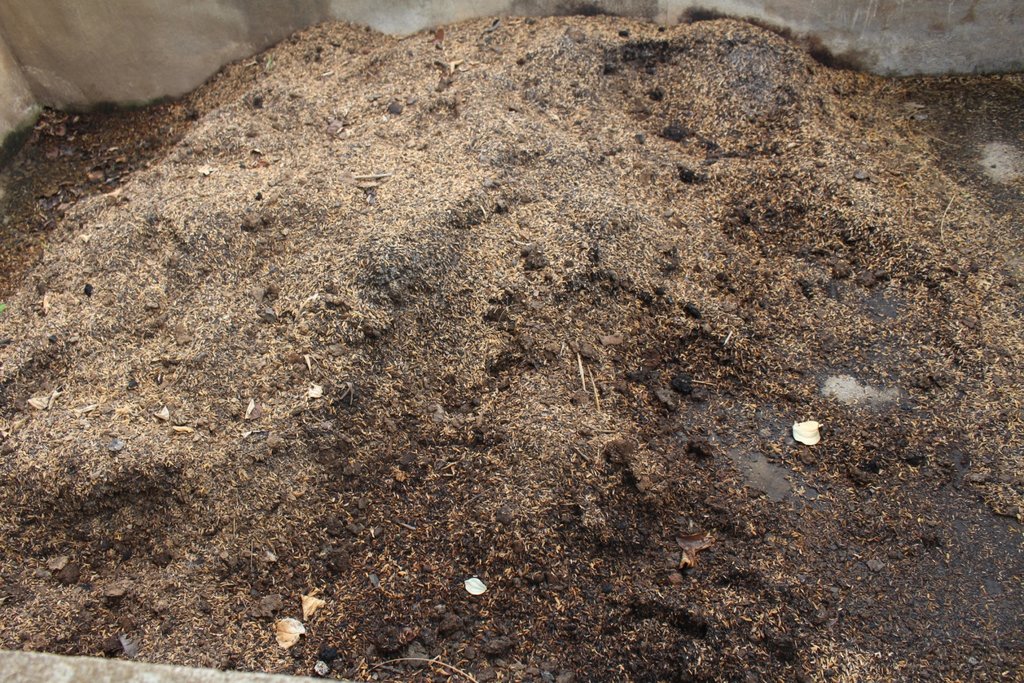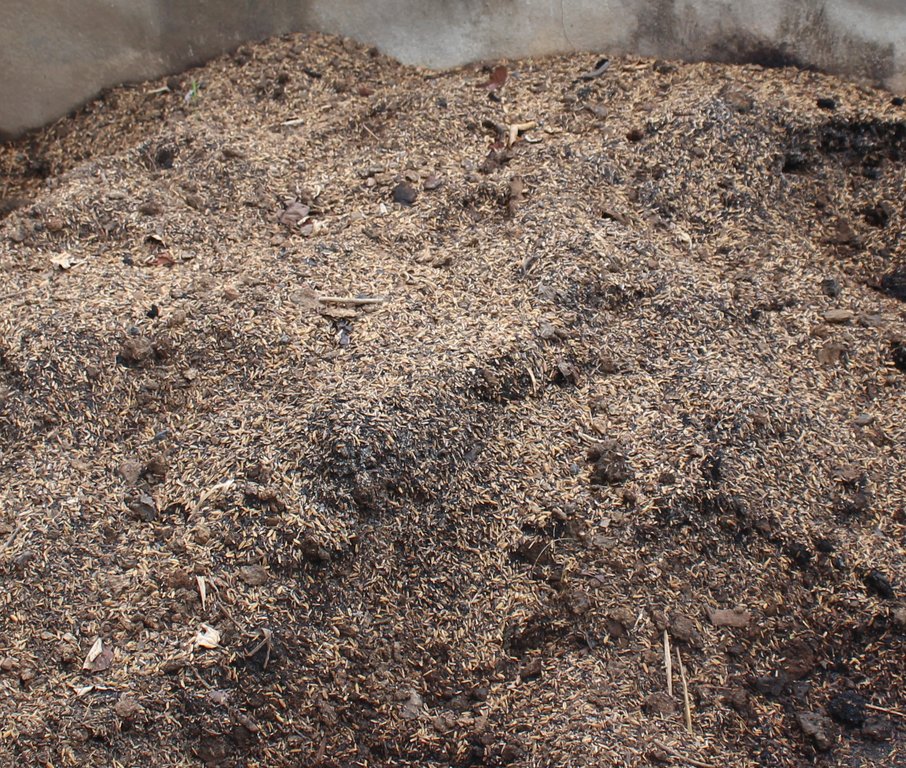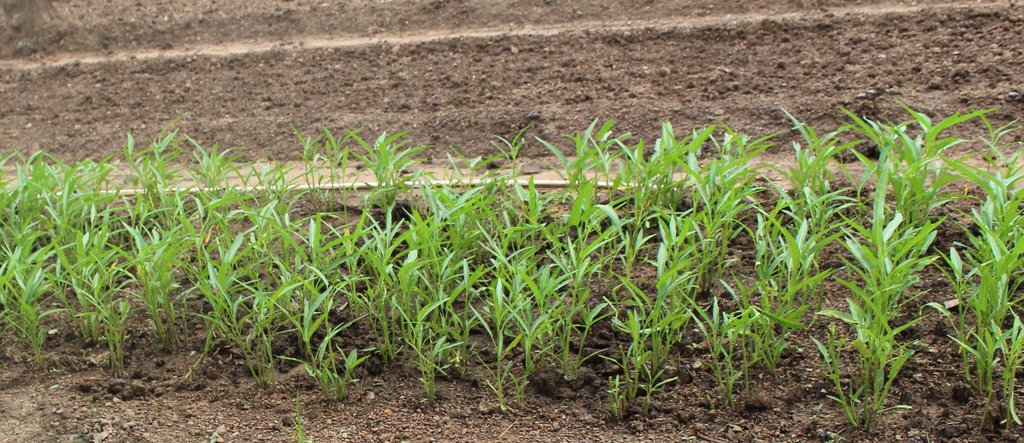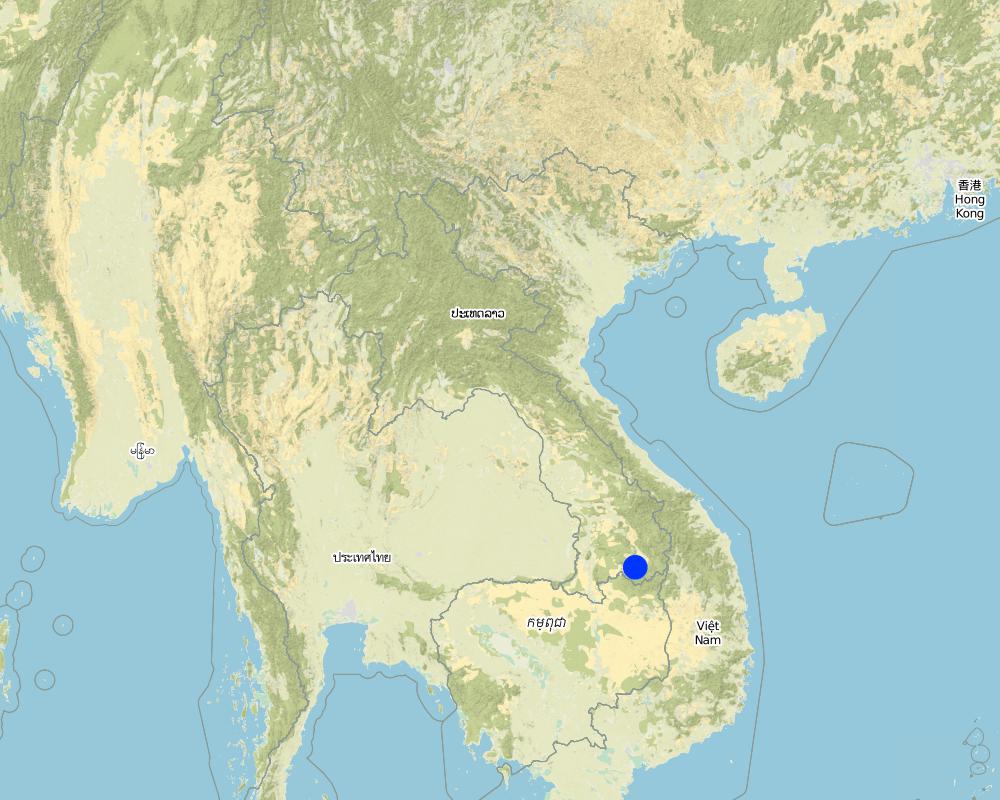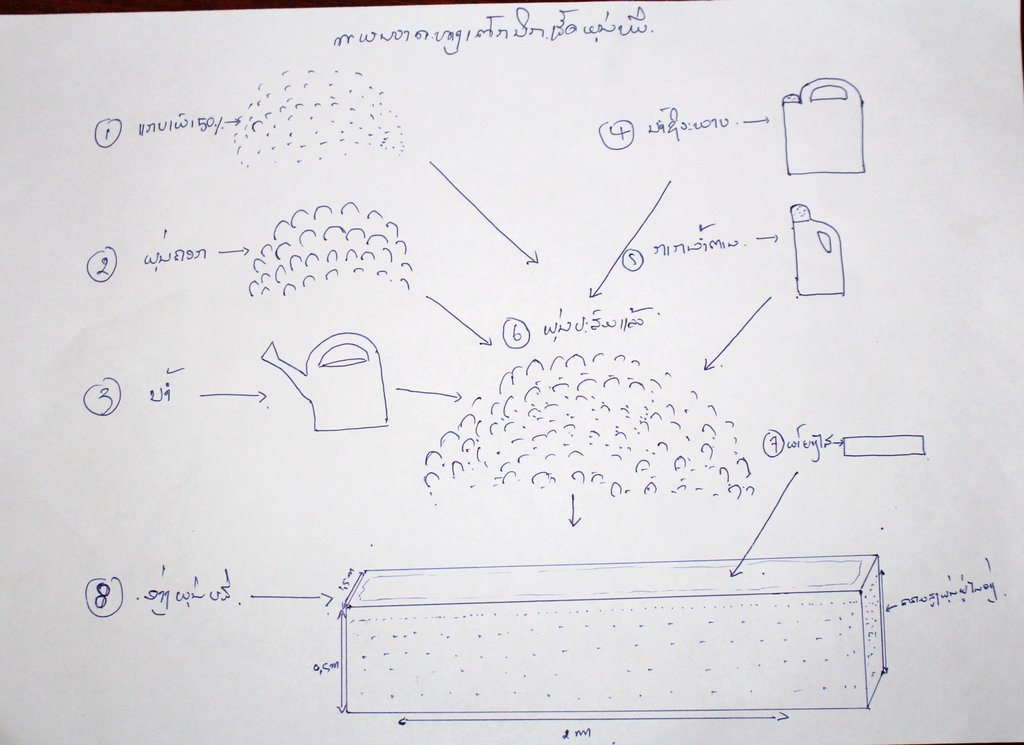ການເຮັດຝຸ່ນບົ່ມ ເພື່ອປັັບປຸງດີນ ຢູ່ພື້ນທີ່ ປູກຜັກສວນຄົວ [Lao People's Democratic Republic]
- Creation:
- Update:
- Compiler: Visay Visay
- Editors: anousit namsena, Pasalath Khounsy, Bounthanom Bouahom
- Reviewers: Nivong Sipaseuth, Nicole Harari
ຝຸ່ນບົ່ມ
technologies_2284 - Lao People's Democratic Republic
View sections
Expand all Collapse all1. General information
1.2 Contact details of resource persons and institutions involved in the assessment and documentation of the Technology
Key resource person(s)
SLM specialist:
ທອງວົງໄຊ ສິດວົງໄຊ
8562095949329
ຫ້ອງການກະສິກຳ ແລະ ປ່າໄມ້ ເມືອງພູວົງ
ບ້ານວົງສຳພັນ, ເມືອງພູວົງ, ແຂວງອັດຕະປື
Lao People's Democratic Republic
land user:
ກຸນລະວົງ ຄຸ
ບ້ານວົງສົມພູ (ຄຸ້ມຕະອູມ), ເມືອງພູວົງ, ແຂວງອັດຕະປື
Lao People's Democratic Republic
Name of project which facilitated the documentation/ evaluation of the Technology (if relevant)
Scaling-up SLM practices by smallholder farmers (IFAD)Name of the institution(s) which facilitated the documentation/ evaluation of the Technology (if relevant)
National Agriculture and Forestry Research Institute (NAFRI) - Lao People's Democratic Republic1.3 Conditions regarding the use of data documented through WOCAT
When were the data compiled (in the field)?
16/05/2017
The compiler and key resource person(s) accept the conditions regarding the use of data documented through WOCAT:
Ja
1.4 Declaration on sustainability of the described Technology
Is the Technology described here problematic with regard to land degradation, so that it cannot be declared a sustainable land management technology?
Nee
2. Description of the SLM Technology
2.1 Short description of the Technology
Definition of the Technology:
ການເຮັດຝຸ່ນບົ່ມ ແມ່ນເຮັດມາຈາກຂ້ີແກບເຜົາ ເພື່ອປັບປຸງດິນ ແລະ ເພ່ີມສະມັດຕະພາບ ຜົນຜະລິດ ພືດຜັກສວນຄົວ ຊຶ່ງເຕັກນີກນ້ີ ແມ່ນເກີດມາຈາກ ແນວຄວາມຄິດລິເລ່ີມ ແລະ ໄດ້ຮັບການສົ່ງເສີມ ຈາກທາງໂຄງການ ຄໍາ້ປະກັນ ສະບຽງ ອາຫານ ແລະ ໂພສະນາການ ເຊື່ອມໂຍງກັບການຕະຫຼາດ ທ່ີໄດ້ຮັບການສະຫນັບສະ ຫນຸນທຶນຈາກ ອົງການ IFAD.
2.2 Detailed description of the Technology
Description:
ກິດຈະກໍາ ການປູກຜັກ ສວນຄົວ ເປັນກິດຈະກໍາ ທ່ີຊາວກະສິກອນ ເຄີຍຈັດຕັ້ງປະຕິບັດ ເພື່ອຄໍາ້ປະກັນ ສະບຽງອາຫານ ແລະ ສ້າງລາຍຮັບ. ໃນເມ່ືອກ່ອນ ການຍົກສະມັດ ຕະພາບຜົນ ຜະລິດ ຂອງປະຊາຊົນ ແມ່ນນໍາໃຊ້ ແຕ່ຝຸ່ນຄອກ ເພື່ອເປັບປຸງດິນ ແລະ ປະລິມານ ການນໍາໃຊ້ຝຸ່ນຄອກ ແມ່ນອີງຕາມ ທ່າແຮງ ແລະ ຄວາມສາມາດ ຂອງຄອບຄົວ. ນອກຈາກນ້ິ, ພື້ນທ່ີ ທໍາການຜະລີດ ຂອງຊາວກະສິກອນ ສ່ວນໃຫຍ່ ແມ່ນເປັນດິນຊາຍ, ຊັ້ນດິນຕ້ືນ ມີຫີນແຮ່ ສະສົມ ຊັ້ນດິນ ທ່ີເກີດຈາກທໍາມະຊາດ ຊ່ຶງບໍ່ອໍານວຍ ແລະ ເປັນຂໍ້ຈຳກັດ ໃນການຜະລິດ ແລະ ພື້ນທີ ປູກຜັກ ສ່ວນໃຫຍ່ ແມ່ນປູກຢູ່ແຄມບາ້ນ ເນ່ືອງຈາກຈໍາກັດ ພື້ນທ່ີ ທໍາການຜະລິດ ແຄມຫ້ວຍ ຫືຼ ແຄມນໍາ້ຕ່າງໆ. ດັ່ງນັ້ນ, ໃນປີ 2016 ທາງແຜນງານ ໂຄງການ ຄໍາ້ປະກັນ ສະບຽງອາຫານ ແລະ ໂພສະນາການ ເຊ່ືອມໂຍງກັບການຕະຫຼາດ (FNML-IFAD) ໄດ້ມາແນະນໍາ ສົ່ງເສີມ ແລະ ຈັດຝຶກອົບຮົມ ກ່ຽວກັບ ວິທີການເຮັດ ຝຸ່ນບົ່ມ ເພື່ອປັບປຸງດິນ ແລະ ເພີ່ມຜົນຜະລິດ ພືດຜັກສວນຄົວ ໃຫ້ແກ່ຊາວກະສິກອນ ພາຍໃນບາ້ນຈໍານວນຫນ່ຶງ ຢູ່ເມືອງພູວົງ ແຂວງອັດຕະປື. ວິທີການ ເຮັດຝຸ່ນບົ່ມ ບ່ໍມີຂັ້ນຕອນຫຍູ້ງຍາກ ແລະ ຊາວກະສິກອນ ສາມາດ ນໍາໃຊ້ ວັດຖຸດີບ ທ່ີມີໃນທອ້ງຖ່ີນ. ຊ່ຶງວັດຖຸດິບ ທ່ີນໍາໃຊ້ເຂົ້າ ໃນການເຮັດຝຸ່ນບົ່ມ ປະກອບມີ ຂ້ີແກບເຜົາໃໝ້ ປະມານ 50% ຈໍານວນ 10 ກະສອບ (15 ກິໂລ/ກະສອບ), ຝຸ່ນຄອກ 20 ກິໂລ, ນໍາ້ 50 ລິດ, ກາກນໍາ້ຕານ 15 ບ່ວງ ຫືຼ ໃຊ້ນ້ຳຕານແທນກ່ໍໄດ້, ນໍາ້ສະກັດຊີວະພາບ 5 ບ່ວງ. ສໍາລັບ ອຸປະກອນ ທ່ີຫາມາໄດ້ນັ້ນ ນໍາມາປະສົມ ໃຫ້ເຂົ້າກັນ ລະອຽດດີ ແລ້ວເອົາລົງໃສ່ອ່າງທ່ີ ໄດ້ກະກຽມດິນ ຂະຫນາດອ່າງ (ທ່ີກໍ່ດວ້ຍຊີເມັນ ຫືຼ ສາມາດໃຊ້ອ່າງຢາງພາດສະຕິກກໍ່ໄດ້) ຄວາມເລິກ 0,5 ແມັດ, ກວ້າງ 1,5 ແມັດ ແລະ ຍາວ 2 ແມັດ. ສ່ວນຝຸ່ນ ປະສົມ ທ່ີເອົາລົງໃສ່ອ່າງນັ້ນ ກວດຝຸ່ນ ໃຫ້ພຽງຫນ້າຂອງອ່າງ, ແລ້ວເອົາຜ້າຢາງໃສ ປົກຄຸມອ່າງ ແລະ ຈິກຂາ້ງ ໃຫ້ແຈບດີ ບ່ໍໃຫ້ມີອາກາດເຂົ້າ, ການບົ່ມຝຸ່ນ ໃຊ້ເວລາ ປະມານ 1-2 ອາທິດ ຈ່ຶງສາມາດ ນໍາໄປໃສ່ສວນປູກຜັກໄດ້. ວິທີການນໍາໃຊ້ ແມ່ນນຳຝຸ່ນບົ່ມ ໃສ່ຄຸ ຫືຼ ກະສອບ ເພື່ອນໍາໄປຫວ່ານ ໃສ່ຫນານປູກຜັກ ໄດ້ເລີຍ ໃນຊ່ວງການກະກຽມດິນ ພາຍຫັຼງ ຫວ່ານຝຸ່ນບົ່ມ ຄຸມຫນານຜັກແລ້ວ ກໍ່ໃຊ້ ຄາດກວດ ຫືຼ ຈົກຂຸດຝຸ່ນບົ່ມ ປະສົມກັບດິນ ໃຫ້ເຂົ້າກັນ ແລ້ວກໍ່ສາມາດ ປູກຜັກໃສ່ໄດ້. ຊຶ່ງຊ່ວງທີ່ປູກຜັກ ແມ່ນທາ້ຍເດືອນທັນວາ ເຖິງ ເດືອນມີນາ (ປູກ 2-3 ຄັ້ງ/ປີ) ໂດຍອາໃສ ນໍາ້ບາດານ ໃນການຫົດຜັກ ເປັນສ່ວນໃຫຍ່. ສະຫຸຼບແລ້ວ, ເຕັກນິກ ການເຮັດຝຸ່ນບົ່ມມີຜົນດີ ທີຊ່ວຍປັບປຸງດິນ ເຮັດໃຫ້ດິນ ສະສົມ ອິນຊີວັດຖຸຫຼາຍຂຶ້ນ, ມີທາດອາຫານຫັຼກ ແລະ ທາດອາຫານເສີມ, ກະ ຕຸ້ນ ການທໍາງານ ຂອງຈຸລິນຊີດິນ ເຮັດໃຫ້ພືດຜັກ ມີການຈະເລີນເຕີບໂຕໄດ້ດີ ສົ່ງຜົນເຮັດໃຫ້ ຜົນຜະລິດ ເພີ່ມຂ້ຶນ. ເຕັກນິກ ດັ່ງກ່າວນ້ີ ບ່ໍມີຂັ້ນຕອນຫຍຸ້ງຍາກ ໃນການບໍາລຸງຮັກສາ ພຽງແຕ່ ຕອ້ງໄດ້ເອົາໃຈໃສ່ ອະນາໃມອ່າງ, ເກັບມຽ້ນ ອຸປະກອນ ເປັນຕົ້ນ ແມ່ນຊວ້ນ ແລະ ບົວຫົດນໍາ້ ເພື່ອໃວ້ໃຊ້ໃນເທ່ືອຕ່ໍໄປ ຂອງການເຮັດຝຸ່ນບົ່ມ ແລະ ທັງເປັນການປະຢັດ ຄ່າຈ້າງແຮງງານ.
2.3 Photos of the Technology
2.5 Country/ region/ locations where the Technology has been applied and which are covered by this assessment
Country:
Lao People's Democratic Republic
Region/ State/ Province:
ແຂວງອັດຕະປື
Further specification of location:
ເມືອງພູວົງ
Map
×2.6 Date of implementation
Indicate year of implementation:
2016
If precise year is not known, indicate approximate date:
- less than 10 years ago (recently)
2.7 Introduction of the Technology
Specify how the Technology was introduced:
- through projects/ external interventions
Comments (type of project, etc.):
ໂຄງການ ຄໍ້າປະກັນ ສະບຽງອາຫານ ແລະ ໂພສະນາການ ເຊື່ອມໂຍງ ກັບການຕະຫຼາດ (IFAD)
3. Classification of the SLM Technology
3.1 Main purpose(s) of the Technology
- improve production
- reduce, prevent, restore land degradation
- preserve/ improve biodiversity
- create beneficial economic impact
- create beneficial social impact
3.2 Current land use type(s) where the Technology is applied

Cropland
- Annual cropping
3.3 Further information about land use
Water supply for the land on which the Technology is applied:
- full irrigation
Number of growing seasons per year:
- 3
3.4 SLM group to which the Technology belongs
- integrated soil fertility management
- waste management/ waste water management
- home gardens
3.5 Spread of the Technology
Specify the spread of the Technology:
- evenly spread over an area
If the Technology is evenly spread over an area, indicate approximate area covered:
- < 0.1 km2 (10 ha)
3.6 SLM measures comprising the Technology

agronomic measures
- A2: Organic matter/ soil fertility
3.7 Main types of land degradation addressed by the Technology

chemical soil deterioration
- Cn: fertility decline and reduced organic matter content (not caused by erosion)

biological degradation
- Bl: loss of soil life
3.8 Prevention, reduction, or restoration of land degradation
Specify the goal of the Technology with regard to land degradation:
- prevent land degradation
- reduce land degradation
4. Technical specifications, implementation activities, inputs, and costs
4.1 Technical drawing of the Technology
4.2 Technical specifications/ explanations of technical drawing
ວິທີ ແລະ ຂັ້ນຕອນ ການເຮັດຝຸ່ນບົ່ມ ມີດັ່ງລຸ່ມນີ້ 1. ຂ້ີແກບເຜົາໃໝ້ ປະມານ 50% (ໄຫມ້ບໍ່ຫມົດ) ຈໍານວນ 10 ກະສອບ (15 ກິໂລ/ກະສອບ), 2. ຝຸ່ນຄອກ 10 ກະສອບ (20 ກີໂລ/ກະສອບ), 3. ນໍາ້ 50 ລິດ, 4. ກາກນໍາ້ຕານ 15 ບ່ວງແກງ, 5. ນໍາ້ ສະກັດຊີວະພາບ 5 ບ່ວງແກງ, 6. ປະສົມ ສ່ວນປະສົມ ທັງຫມົດເຂົ້າກັນແລ້ວ ເກັບຮັກສາໄວ້ໃນອ່າງ ໂດຍເອົາຜ້າຢາງປົກອ່າງໄວ້.
4.3 General information regarding the calculation of inputs and costs
Specify how costs and inputs were calculated:
- per Technology area
Indicate size and area unit:
5 x 5 ແມັດ
other/ national currency (specify):
ກີບ
Indicate exchange rate from USD to local currency (if relevant): 1 USD =:
8000.0
Indicate average wage cost of hired labour per day:
50000
4.4 Establishment activities
| Activity | Type of measure | Timing | |
|---|---|---|---|
| 1. | ກໍ່ສ້າງອ່າງຊິເມັນ ເກັບມ້ຽນຝຸ່ນບົ່ມ | Structural | ທ້າຍເດືອນທັນວາ |
4.5 Costs and inputs needed for establishment
| Specify input | Unit | Quantity | Costs per Unit | Total costs per input | % of costs borne by land users | |
|---|---|---|---|---|---|---|
| Labour | ແຮງງານ ໃນການກໍ່ສ້າງອ່າງ (ຮັບເໝົາ) | 1.0 | 500000.0 | 500000.0 | 100.0 | |
| Equipment | ບົວຫົດນຳ້ | ໜ່ວຍ | 1.0 | 25000.0 | 25000.0 | 100.0 |
| Equipment | ຄຸ | ໜ່ວຍ | 2.0 | 7500.0 | 15000.0 | 100.0 |
| Equipment | ຊວ້ານ | ດວງ | 1.0 | 20000.0 | 20000.0 | 100.0 |
| Equipment | ກະສອບ ໃສ່ຂີ້ແກບ ແລະ ຝຸ່ນຄອກ | ໜ່ວຍ | 20.0 | 2000.0 | 40000.0 | 100.0 |
| Equipment | ຜ້າຢາງປາດສະຕິກ | ແມັດ | 3.0 | 10000.0 | 30000.0 | 100.0 |
| Construction material | ກ້ອນດິນຈີ່ | ກ້ອນ | 100.0 | 4000.0 | 400000.0 | 100.0 |
| Construction material | ຊິມັງ | ເປົາ | 7.0 | 40000.0 | 280000.0 | 100.0 |
| Construction material | ດິນຊາຍ | ລົດ | 0.5 | 300000.0 | 150000.0 | 100.0 |
| Total costs for establishment of the Technology | 1460000.0 | |||||
4.6 Maintenance/ recurrent activities
| Activity | Type of measure | Timing/ frequency | |
|---|---|---|---|
| 1. | ເກັບຂີ້ແກບເຜົາ | Management | ພາຍຫຼັງ ສຳລັບການເກັບກ່ຽວ |
| 2. | ເກັບຝຸ່ນຄອກ | Management | ພາຍຫຼັງ ສຳລັບການເກັບກ່ຽວ |
| 3. | ກະກຽມ ວັດຖຸດິບ ທີ່ຈະໃຊ້ ໃນການເຮັດຝຸ່ນຄອກ | Management | ພາຍຫຼັງ ສຳເລັດການເກັບກ່ຽວ |
| 4. | ນຳໃຊ້ຝຸ່ນບົ່ມ ໃນພື້ນທີ່ ປູກຜັກສວນຄົວ | Management | ພາຍຫຼັງ ສຳເລັດການເກັບກ່ຽວ |
4.7 Costs and inputs needed for maintenance/ recurrent activities (per year)
| Specify input | Unit | Quantity | Costs per Unit | Total costs per input | % of costs borne by land users | |
|---|---|---|---|---|---|---|
| Labour | ແຮງງານ ໃນການກະກຽມ ວັດຖູດິບ ເພື່ອເຮັດຝຸ່ນບົ່ມ | ວັນງານ | 2.0 | 50000.0 | 100000.0 | 100.0 |
| Labour | ແຮງງານ ໃນການເຮັດຝຸ່ນບົ່ມ | ວັນງານ | 2.0 | 50000.0 | 100000.0 | 100.0 |
| Labour | ແຮງງານ ໃນການນຳໃຊ້ຝູ່ນບົ່ມ ໄປໃສ່ສວນຜັກ | ວັນງານ | 2.0 | 50000.0 | 100000.0 | 100.0 |
| Fertilizers and biocides | ຝູ່ນຄອກ | ກິໂລ | 10.0 | 5000.0 | 50000.0 | 100.0 |
| Other | ຂີ້ແກບເຜົາ | ກະສອບ | 10.0 | 20000.0 | 200000.0 | 100.0 |
| Other | ນ້ຳຕານ | ກິໂລ | 1.0 | 10000.0 | 10000.0 | 100.0 |
| Other | ນ້ຳສະກັດ ຊີວະພາບ | ລິດ | 1.0 | 10000.0 | 10000.0 | 100.0 |
| Total costs for maintenance of the Technology | 570000.0 | |||||
4.8 Most important factors affecting the costs
Describe the most determinate factors affecting the costs:
ຕົ້ນທຶນ ໃນການກໍ່ສ້າງອ່າງ ເກັບມ້ຽນ ຝຸ່ນບົ່ມ ຊຶ່ງເປັນປັດໃຈຫຼັກ ທີ່ມີສົ່ງຜົນເຮັດໃຫ້ ຕົ້ນທຶນສູງ (ຖ້າເປັນໄປໄດ້ ກ່ໍສາມາດໃຊ້ອ່າງ ທ່ີເຄີຍລຽ້ງປາໃສ່ ທ່ີບ່ໍໄດ້ໃຊ້ແລ້ວກ່ໍໄດ້).
5. Natural and human environment
5.1 Climate
Annual rainfall
- < 250 mm
- 251-500 mm
- 501-750 mm
- 751-1,000 mm
- 1,001-1,500 mm
- 1,501-2,000 mm
- 2,001-3,000 mm
- 3,001-4,000 mm
- > 4,000 mm
Agro-climatic zone
- sub-humid
5.2 Topography
Slopes on average:
- flat (0-2%)
- gentle (3-5%)
- moderate (6-10%)
- rolling (11-15%)
- hilly (16-30%)
- steep (31-60%)
- very steep (>60%)
Landforms:
- plateau/plains
- ridges
- mountain slopes
- hill slopes
- footslopes
- valley floors
Altitudinal zone:
- 0-100 m a.s.l.
- 101-500 m a.s.l.
- 501-1,000 m a.s.l.
- 1,001-1,500 m a.s.l.
- 1,501-2,000 m a.s.l.
- 2,001-2,500 m a.s.l.
- 2,501-3,000 m a.s.l.
- 3,001-4,000 m a.s.l.
- > 4,000 m a.s.l.
Indicate if the Technology is specifically applied in:
- concave situations
5.3 Soils
Soil depth on average:
- very shallow (0-20 cm)
- shallow (21-50 cm)
- moderately deep (51-80 cm)
- deep (81-120 cm)
- very deep (> 120 cm)
Soil texture (topsoil):
- coarse/ light (sandy)
Soil texture (> 20 cm below surface):
- coarse/ light (sandy)
Topsoil organic matter:
- low (<1%)
5.4 Water availability and quality
Ground water table:
5-50 m
Availability of surface water:
medium
Water quality (untreated):
for agricultural use only (irrigation)
Is water salinity a problem?
Nee
Is flooding of the area occurring?
Nee
5.5 Biodiversity
Species diversity:
- low
Habitat diversity:
- low
5.6 Characteristics of land users applying the Technology
Sedentary or nomadic:
- Sedentary
Market orientation of production system:
- mixed (subsistence/ commercial
Off-farm income:
- > 50% of all income
Relative level of wealth:
- average
Individuals or groups:
- individual/ household
Level of mechanization:
- manual work
Gender:
- women
Age of land users:
- middle-aged
5.7 Average area of land owned or leased by land users applying the Technology
- < 0.5 ha
- 0.5-1 ha
- 1-2 ha
- 2-5 ha
- 5-15 ha
- 15-50 ha
- 50-100 ha
- 100-500 ha
- 500-1,000 ha
- 1,000-10,000 ha
- > 10,000 ha
Is this considered small-, medium- or large-scale (referring to local context)?
- small-scale
5.8 Land ownership, land use rights, and water use rights
Land ownership:
- individual, not titled
Land use rights:
- individual
Water use rights:
- individual
5.9 Access to services and infrastructure
health:
- poor
- moderate
- good
education:
- poor
- moderate
- good
technical assistance:
- poor
- moderate
- good
employment (e.g. off-farm):
- poor
- moderate
- good
markets:
- poor
- moderate
- good
energy:
- poor
- moderate
- good
roads and transport:
- poor
- moderate
- good
drinking water and sanitation:
- poor
- moderate
- good
financial services:
- poor
- moderate
- good
6. Impacts and concluding statements
6.1 On-site impacts the Technology has shown
Socio-economic impacts
Production
crop quality
Quantity before SLM:
20 ກິໂລ/ໜານ
Quantity after SLM:
28 ກິໂລ/ໜານ
production area
Comments/ specify:
ເນື່ອງຈາກຊາວກະສິກອນ ໄດ້ຮັບຜົນຜະລິດ ເປັນທີ່ໜ້າພໍໃຈ ຊຶ່ງໄດ້ມີການຂະຫຍາຍ ເນື້ອທີ່ ປູກຜັກກວ້າງອອກຕື່ມ.
Income and costs
farm income
Comments/ specify:
ກ່ອນການນໍາໃຊ້ ຝຸ່ນບົ່ມ ຊາວກະສິກອນ ສ່ວນໃຫຍ່ ປູກຜັກ ໄວ້ກິນ ພາຍໃນຄອບຄົວ ແຕ່ພາຍຫັຼງ ຈາກໃຊຝຸ່ນບົ່ມ ເຫັນວ່າ ຊາວກະສິກອນ ສາມາດ ຂາຍຜັກ ເປັນສິນຄ້າໄດ້.
workload
Comments/ specify:
ຊາວກະສິກອນ ມີວຽກເພີ່ມຂ້ຶນ ໂດຍສະເພາະ ແມ່ນຂະບວນການເຮັດຝຸ່ນບົ່ມ.
Socio-cultural impacts
SLM/ land degradation knowledge
Comments/ specify:
ຊາວກະສິກອນ ໄດ້ຮັບການຝຶກອົບຮົມ ແລະ ໄດ້ຮັບຄວາມຮູ້ ໃນການເຮັດຝຸ່ນບົ່ມ ເພື່ອປັບ ປຸງດິນ ໃນພື້ນທ່ີ ປູກຜັກສວນຄົວ.
Ecological impacts
Soil
soil accumulation
Comments/ specify:
ຊ່ຶງການເຮັດເຕັກນີກນ້ີ ຍັງຢູ່ໃນຊ່ວງໄລຍະທົດລອງ (2017)
nutrient cycling/ recharge
Comments/ specify:
ຊ່ຶງການເຮັດເຕັກນີກນ້ີ ຍັງຢູ່ໃນຊ່ວງໄລຍະທົດລອງ (2017)
Biodiversity: vegetation, animals
habitat diversity
Comments/ specify:
ເກີດມີຈຸລິນຊີໃນດິນ ແລະ ຂີ້ກະເດືອນຫຼາຍຂື້ນ.
pest/ disease control
Comments/ specify:
ຫຸຼດຜອ່ນບັນຫາ ສັດຕຸພືດ ເຂົ້າມາທໍາລາຍພືດຜັກ
6.3 Exposure and sensitivity of the Technology to gradual climate change and climate-related extremes/ disasters (as perceived by land users)
Gradual climate change
Gradual climate change
| Season | Type of climatic change/ extreme | How does the Technology cope with it? | |
|---|---|---|---|
| annual rainfall | decrease | moderately |
6.4 Cost-benefit analysis
How do the benefits compare with the establishment costs (from land users’ perspective)?
Short-term returns:
slightly negative
Long-term returns:
neutral/ balanced
How do the benefits compare with the maintenance/ recurrent costs (from land users' perspective)?
Short-term returns:
slightly negative
Long-term returns:
slightly positive
6.5 Adoption of the Technology
- 1-10%
Of all those who have adopted the Technology, how many have did so spontaneously, i.e. without receiving any material incentives/ payments?
- 0-10%
6.6 Adaptation
Has the Technology been modified recently to adapt to changing conditions?
Nee
6.7 Strengths/ advantages/ opportunities of the Technology
| Strengths/ advantages/ opportunities in the land user’s view |
|---|
| ການຊອກຫາ ອຸປະກອນ ແລະ ວັດຖຸດິບ ມາເຮັດຝຸ່ນບົ່ມ ແມ່ນຫາໄດ້ງ່າຍ ແລະ ມີໃນທ້ອງຖີ່ນ. |
| ການນຳໃຊ້ຝຸ່ນບົ່ມ ໃສ່ໜານຜັກ ແມ່ນຊ່ວຍໃຫ້ພືດຜັກ ຈະເລີນເຕີບໂຕດີ ແລະ ຍັງສາມາດ ປັບປຸງດິນ ໃຫ້ມີຄວາມອຸດົມສົມບຸນ. |
| ເປັນໂອກາດທີດີ ທີ່ຊາວກະສິກອນ ໄດ້ມີການປຶກສາຫາລື ແລະ ແລກປ່ຽນບົດຮຽນ ກັບພະນັກງານວິຊາການ. |
| Strengths/ advantages/ opportunities in the compiler’s or other key resource person’s view |
|---|
| ການນໍາໃຊ້ ຝຸ່ນບົ່ມ ສາມາດ ປັບປຸງດິນ ໃຫ້ມີຄວາມອຸດົມສົມບຸນ |
| ການເຮັດເຕັກນິກດັ່ງກ່າວ ຖ້າວ່າເຮັດໃນຈໍານວນຫຼາຍ ສາມາດ ນໍາໄປປັບປຸງດິນ ໃນພື້ນທ່ີຫຼາຍໄດ້ ຫືຼ ສາມາດ ເຮັດຂາຍ ເພື່ອສ້າງລາຍຮັບໃຫ້ແກ່ຄອບຄົວ. |
6.8 Weaknesses/ disadvantages/ risks of the Technology and ways of overcoming them
| Weaknesses/ disadvantages/ risks in the land user’s view | How can they be overcome? |
|---|---|
| ຜົນທ່ີໄດ້ຮັບ ຈາກການເຮັດ ເຕັກນີກ ຝຸ່ນບົ່ມ ຍັງເຮັດໃນພື້ນທ່ີຈໍາກັດ ເນ່ືອງຈາກວ່າ ຍັງເປັນຊ່ວງໄລຍະທົດລອງຢູ່ (2017). | |
| ການເຮັດຝຸ່ນບົ່ມ ແມ່ນຈະເຫັນຜົນ ໃນໄລຍະຍາວ ຊ່ຶງຈະຕອ້ງໄດ້ໃຊ້ເວລາ ໃນການປັບປຸງດິນ (ແຕກຕ່າງກັບ ການໃຊ້ຝຸ່ນເຄມີ ທີ່ສາມາດ ເຫັນຜົນໄດ້ໄວ). | |
| ຖາ້ຫາກ ຊາວກະສິກອນ ຕອ້ງການຈະໃຊ້ຝຸ່ນບົ່ມ ຢູ່ທົ່ງນາ ແມ່ນເປັນໄປໄດ້ຍາກ ເນ່ືອງຈາກປະລິມານຝຸ່ນບົ່ມ ມີຈໍາກັດ ຊ່ຶງຕອ້ງໄດ້ອາໃສ ແຮງງານ ໃນການເກັບ ແລະ ກະກຽມວັດຖຸດິບ ໃນການເຮັດຝຸ່ນບົ່ມຫຼາຍຄົນ. | ທ່ີສໍາຄັນ ແມ່ນຄວນໃຫ້ມີການ ສ້າງອ່າງຊິມັງ ເພື່ອ ບົ່ມຝຸ່ນ ໄວ້ໃຊ້ເປັນປະລິມານ ທ່ີຫຼວງຫຼາຍ ແລະ ສາມາດ ເກັບໄວ້ ເມ່ືອຕອ້ງການນໍາໃຊ້ ກ່ໍສາມາດໃຊ້ໄດ້. |
| Weaknesses/ disadvantages/ risks in the compiler’s or other key resource person’s view | How can they be overcome? |
|---|---|
| ຊາວກະສິກອນ ຍັງບ່ໍທັນເຫັນຜົນປະໂຫຍດ ແລະ ຄວາມສໍາຄັນ ຂອງຝຸ່ນບົ່ມ ຫຼາຍເທົ່າທ່ີຄວນ. | ຄວນມີການເຜີຍ ແຜ່ຄວາມຮູ້ ແລະ ຜົນດີ ຈາກການເຮັດຝຸ່ນບົ່ມ ໃນຂັ້ນຊຸມຊົນ ໃຫ້ເຫັນໄດ້ເຖິງຄວາມສໍາຄັນ ຂອງຝຸ່ນບົ່ມ ແລະ ພອ້ມທັງ ມີການຈັດທັດສະນະສຶກສາ ແລກປ່ຽນບົດຮຽນ ລະຫວ່າງຊາວກະສິກອນ ກັບ ຊາວກະສິກອນເອງ. |
7. References and links
7.1 Methods/ sources of information
- field visits, field surveys
1
- interviews with land users
1
Links and modules
Expand all Collapse allLinks
No links
Modules
No modules



